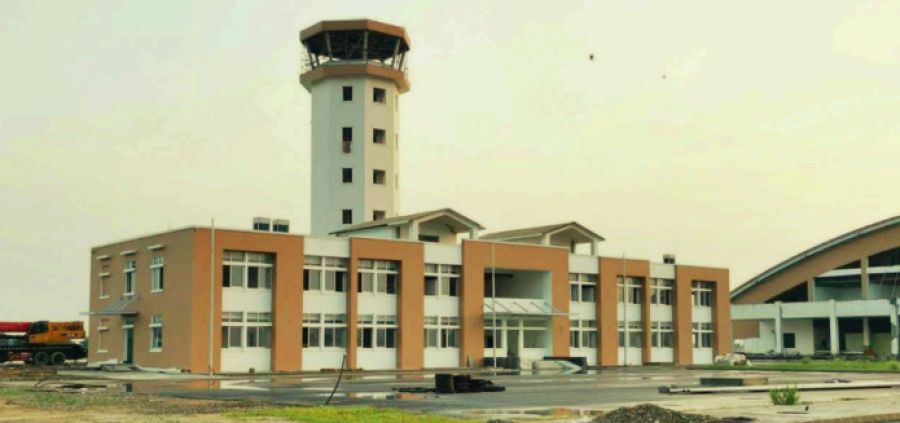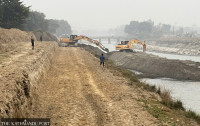National
Plan for airport in Bhairahawa to be fully solar powered gains momentum
The solar plant is estimated to cost nearly $10 million, or $1 million per megawatt, and will take around six months to complete.
Sangam Prasain
The plan to make the international airport in Bhairahawa a fully solar-powered facility is becoming reality after two concerned ministers on Friday decided to address all the issues that had been derailing the project for nearly a year.
The Nepal Electricity Authority had planned to install solar panels on a vast tract of unused lands within the airport complex to produce around 10 megawatts power as part of its plan to diversify the country's energy sources by involving the private sector.
This will enable the Gautam Buddha International Airport to run fully on power from the sun. The surplus power will be fed into the national grid.
The airport project in Bhairahawa could become the second fully solar-powered airport in the world when it opens next year after India's Cochin International Airport which earned the distinction in 2015.
Earlier, the project had hit a snag due to the issue of rental rates for the land belonging to the Civil Aviation Authority of Nepal.
In a new development, Energy Minister Barshaman Pun and Tourism Minister Yogesh Bhattarai held a meeting on Friday and decided to resolve problems that have been holding back the project.
“Both ministers have directed the Civil Aviation Authority of Nepal and Nepal Electricity Authority to draft a suitable proposal regarding the issue of rental rates and other operation and payment modalities within the next 10 days,” said Rajan Pokhrel, director general of the Civil Aviation Authority of Nepal.
“The expert team of both sides will suggest the appropriate lease model. Then the ministers will take the proposal to the Cabinet to allow leasing the airport’s land at a reasonable rate,” he said.
According to the officials at the civil aviation body, if the project materialises, the airport will be the country’s first “power-neutral” airport—which means that the airport’s entire power requirement will be met through the solar power plant it houses.
The solar plan had also set off an argument between the Civil Aviation Authority and the Nepal Electricity Authority over sharing the income generated from energy trade.
“Still, if we buy the solar energy from the private producers, it will cost us nearly three times more than what we get from the state-owned power utility,” said Pokhrel. “Therefore, our plan is to buy electricity from the Nepal Electricity Authority instead of exchanging the power with the land we lease them or other parties.”
The power utility had also expressed concerns over expensive rental rates to lease 10 hectares, or 61 bighas, of the civil aviation body’s land. It will cost them more than Rs200 million annually which they said would not be financially feasible for the project.
“This issue will also be resolved through negotiations,” said Pokhrel.
According to the official at the civil aviation body, the project will require 10 hectares of land to install the solar plants. As per the airport service charge regulation, based on the Tribhuvan International Airport service charge regulation, the land lease fee for civil aviation or business purposes is Rs600 per square metre annually. The same fee for leasing land for agricultural purposes is Rs1,000 per ropani or 508.74 sq m per year.
On Friday, Energy Minister Pun and Tourism Minister Bhattarai agreed to resolve the rental rate issue.
“We will soon finalise a reasonable rate and negotiation will take place if the Nepal Electricity Authority agrees on the fees,” said Pokhrel. “After both parties agree on the new rates, it will be tabled in the Cabinet to get its approval. The approval will then allow both parties to sign the agreement and execute the project.”
In July last year, a team of energy and aviation officials had visited Malaysia to study the solar power system at Kuala Lumpur International Airport, which is powered by a 19-megawatt direct current system installed in 2014, and concluded that the plan to make Bhairahawa airport a fully solar-powered airport was technically viable.
The study has shown that installing a solar farm on the airport premises will not pose a risk to flight safety, handling and communications equipment.
Gautam Buddha International Airport is expected to be completed next year.
Once fully solar-powered, the entire airport operation—from air traffic control, baggage claim and runway lights to ground control rooms and passenger terminals—will run on solar energy.
Utilising airport space to install solar panels will allow electricity to be generated at the point of consumption, eliminating energy bills and the need for expensive transmission lines and supporting infrastructure.




 13.12°C Kathmandu
13.12°C Kathmandu















